Abstract
Episodic ataxia (EA) is a rare, familial disorder producing attacks of generalized ataxia, with normal or near-normal neurological function between attacks. Families with autosomal dominant EA represent at least two distinct clinical syndromes. One clinical type of EA (MIM 160120) includes individuals who have episodes of ataxia and dysarthria lasting seconds to minutes. In addition, myokymia (rippling of muscles, diagnosable by electromyography) is evident during and between attacks. Since K+ channel genes are candidate genes for EA, we tested markers near known K+ channel genes for linkage. Using a group of Genethon markers from one such region--chromosome 12p--we found evidence of linkage in four EA/myokymia families. A maximum combined lod score of 13.6 was obtained at theta = 0, with the marker D12S99. A human Ca++ channel gene, CACNL1A1, and three human K+ channel genes--KCNA5, KCNA6, and KCNA1--map close to D12S99, but the Ca++ channel gene is unlikely to be the site of the defect, because crossovers have been observed to occur between the disease gene and a CA-repeat marker located close to this gene. Studies of a large EA family with a different clinical phenotype (MIM 108500), which lacks myokymia but is associated with nystagmus, have excluded the gene causing that disease from the chromosome 12p locus.
Full text
PDF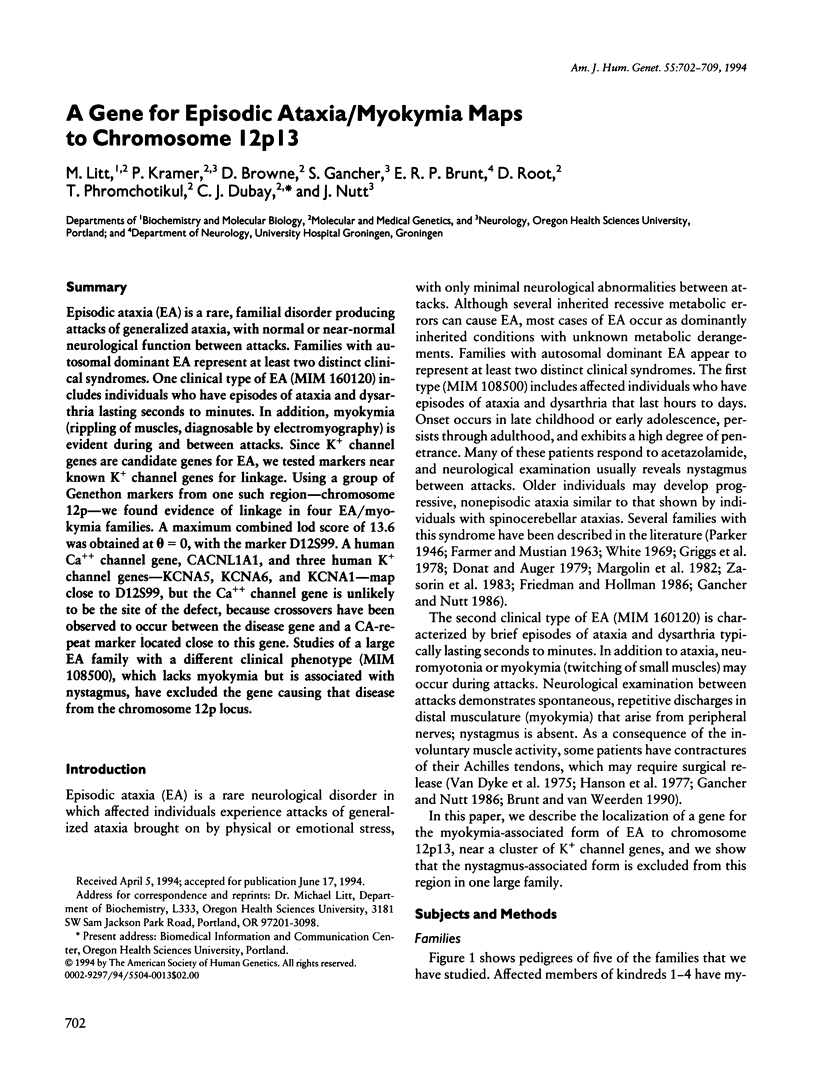
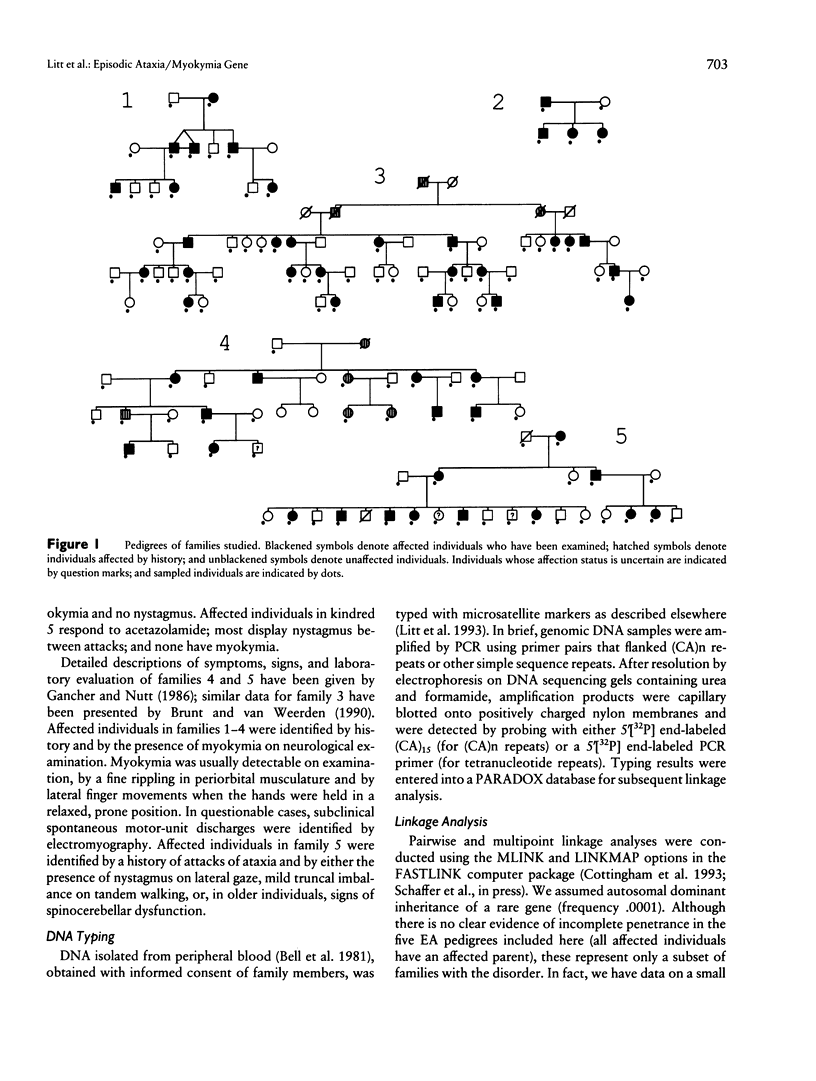
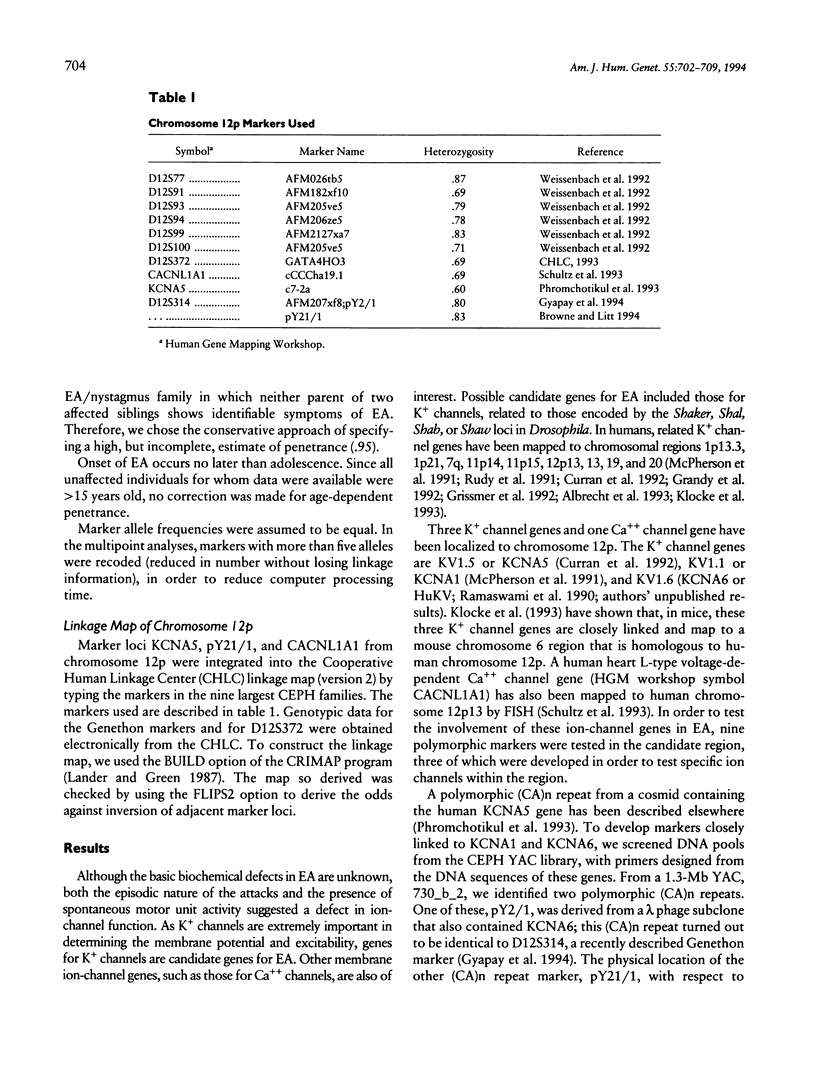
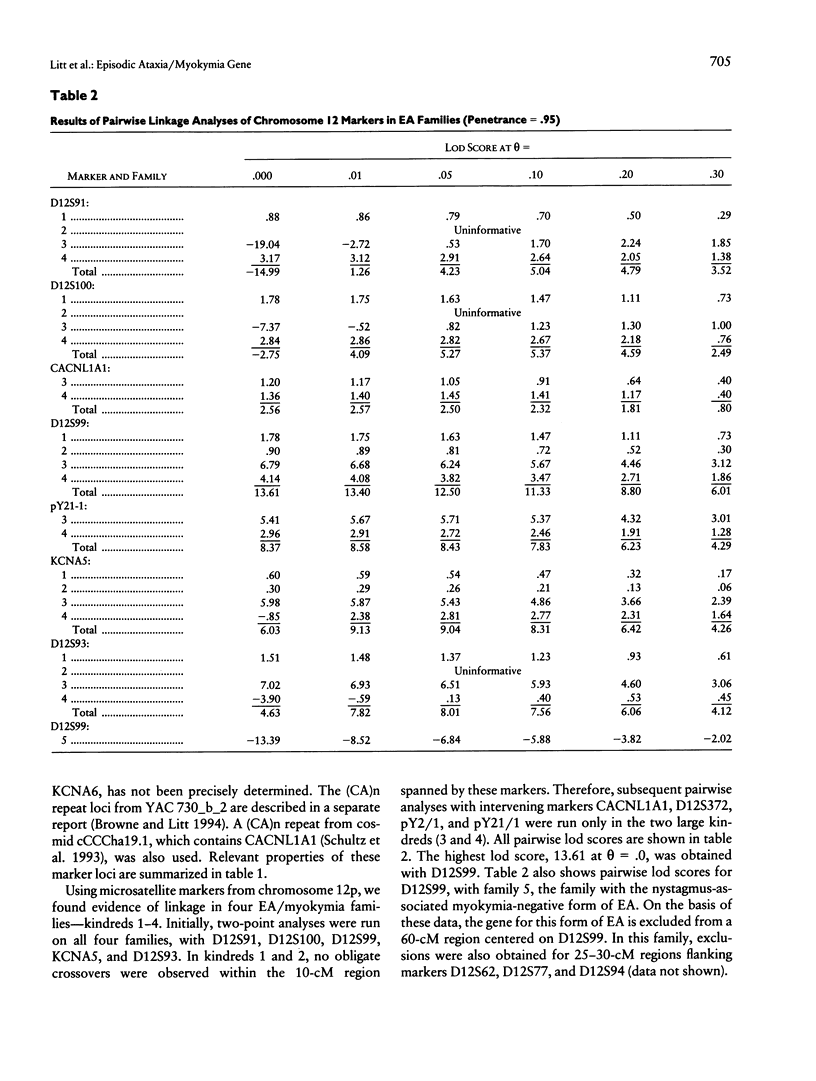
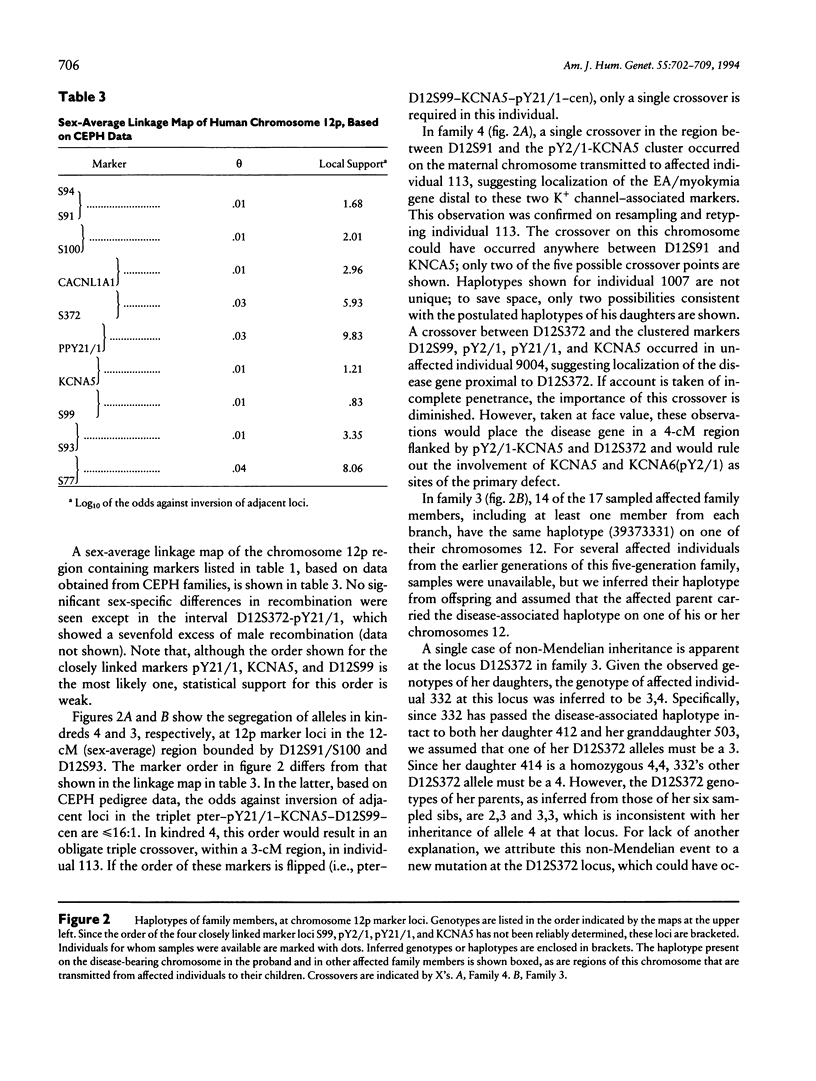
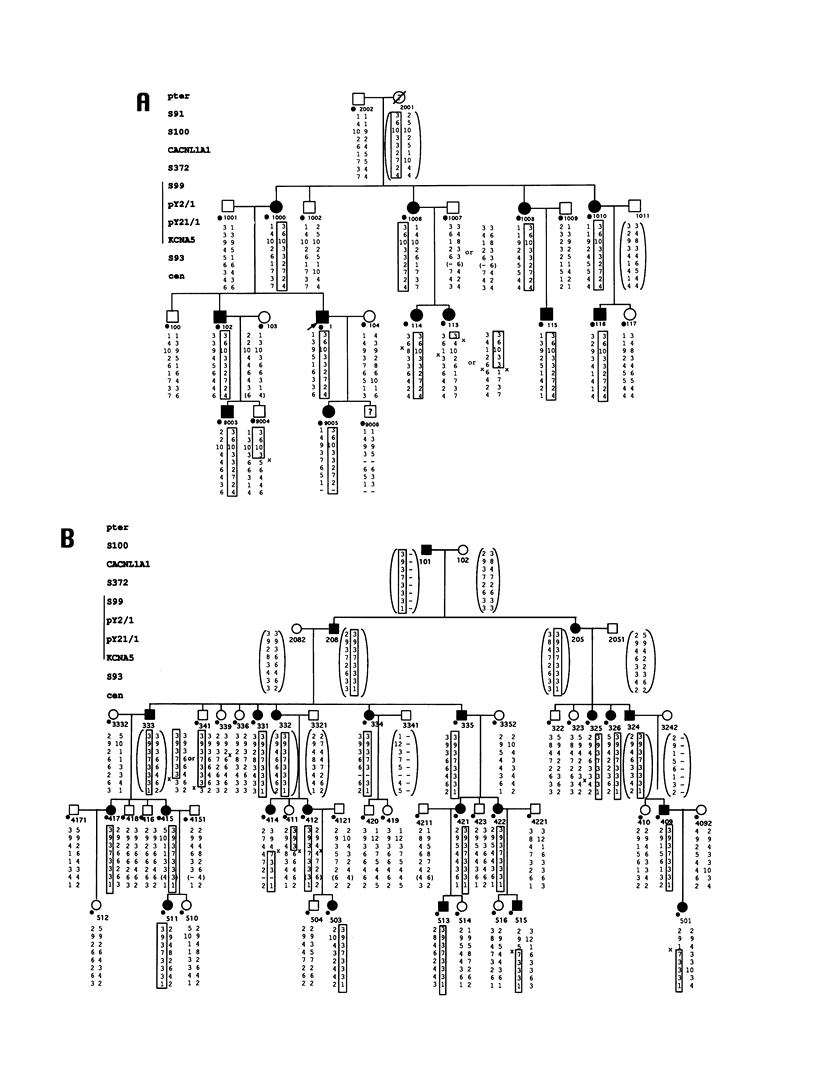
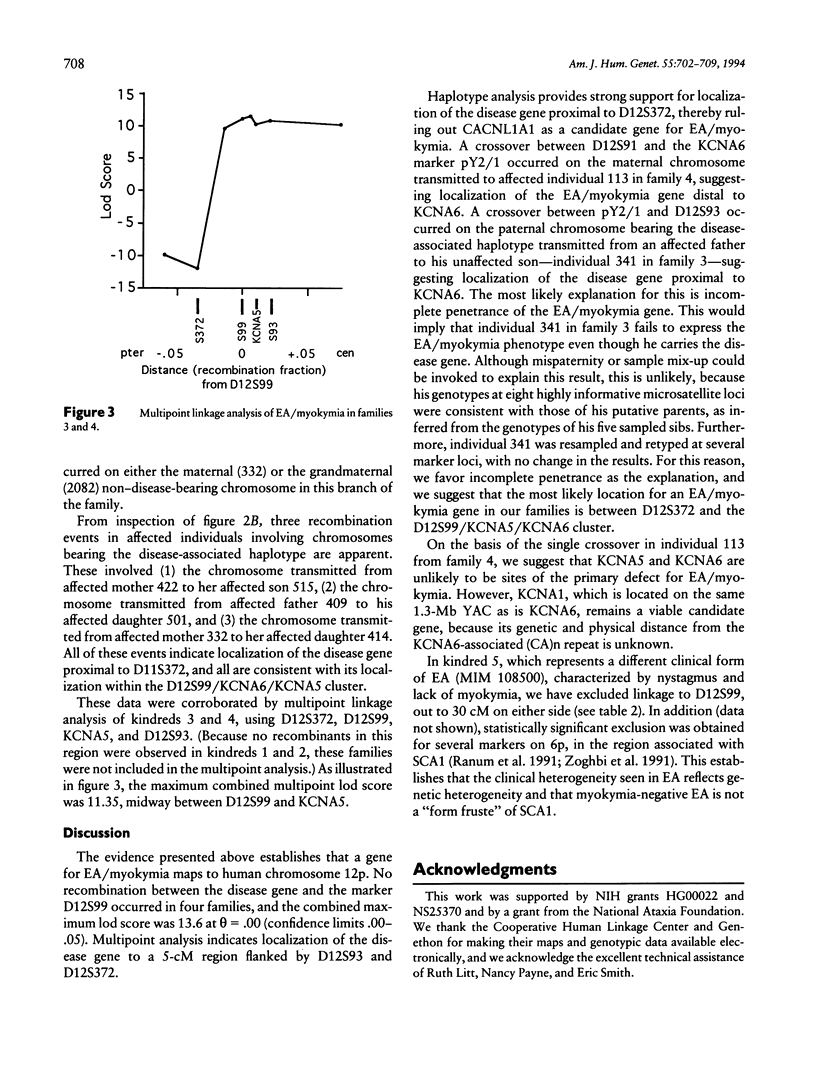
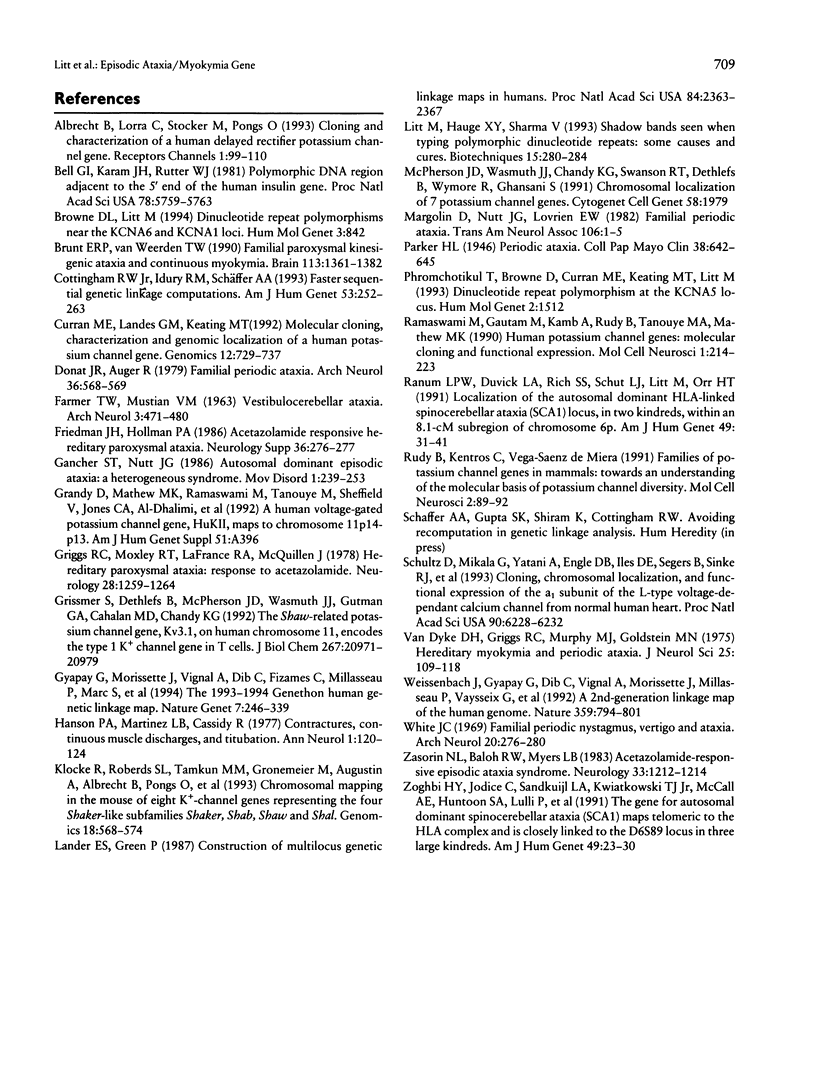
Selected References
These references are in PubMed. This may not be the complete list of references from this article.
- Albrecht B., Lorra C., Stocker M., Pongs O. Cloning and characterization of a human delayed rectifier potassium channel gene. Receptors Channels. 1993;1(2):99–110. [PubMed] [Google Scholar]
- Bell G. I., Karam J. H., Rutter W. J. Polymorphic DNA region adjacent to the 5' end of the human insulin gene. Proc Natl Acad Sci U S A. 1981 Sep;78(9):5759–5763. doi: 10.1073/pnas.78.9.5759. [DOI] [PMC free article] [PubMed] [Google Scholar]
- Browne D. L., Litt M. Dinucleotide repeat polymorphisms near the KCNA6 and KCNA1 loci. Hum Mol Genet. 1994 May;3(5):842–842. doi: 10.1093/hmg/3.5.842-a. [DOI] [PubMed] [Google Scholar]
- Brunt E. R., van Weerden T. W. Familial paroxysmal kinesigenic ataxia and continuous myokymia. Brain. 1990 Oct;113(Pt 5):1361–1382. doi: 10.1093/brain/113.5.1361. [DOI] [PubMed] [Google Scholar]
- Cottingham R. W., Jr, Idury R. M., Schäffer A. A. Faster sequential genetic linkage computations. Am J Hum Genet. 1993 Jul;53(1):252–263. [PMC free article] [PubMed] [Google Scholar]
- Curran M. E., Landes G. M., Keating M. T. Molecular cloning, characterization, and genomic localization of a human potassium channel gene. Genomics. 1992 Apr;12(4):729–737. doi: 10.1016/0888-7543(92)90302-9. [DOI] [PubMed] [Google Scholar]
- Donat J. R., Auger R. Familial periodic ataxia. Arch Neurol. 1979 Sep;36(9):568–569. doi: 10.1001/archneur.1979.00500450062011. [DOI] [PubMed] [Google Scholar]
- FARMER T. W., MUSTIAN V. M. Vestibulocerebellar ataxia. A newly defined hereditary syndrome with periodic manifestations. Arch Neurol. 1963 May;8:471–480. doi: 10.1001/archneur.1963.00460050021002. [DOI] [PubMed] [Google Scholar]
- Gancher S. T., Nutt J. G. Autosomal dominant episodic ataxia: a heterogeneous syndrome. Mov Disord. 1986;1(4):239–253. doi: 10.1002/mds.870010404. [DOI] [PubMed] [Google Scholar]
- Griggs R. C., Moxley R. T., 3rd, Lafrance R. A., McQuillen J. Hereditary paroxysmal ataxia: response to acetazolamide. Neurology. 1978 Dec;28(12):1259–1264. doi: 10.1212/wnl.28.12.1259. [DOI] [PubMed] [Google Scholar]
- Grissmer S., Ghanshani S., Dethlefs B., McPherson J. D., Wasmuth J. J., Gutman G. A., Cahalan M. D., Chandy K. G. The Shaw-related potassium channel gene, Kv3.1, on human chromosome 11, encodes the type l K+ channel in T cells. J Biol Chem. 1992 Oct 15;267(29):20971–20979. [PubMed] [Google Scholar]
- Gyapay G., Morissette J., Vignal A., Dib C., Fizames C., Millasseau P., Marc S., Bernardi G., Lathrop M., Weissenbach J. The 1993-94 Généthon human genetic linkage map. Nat Genet. 1994 Jun;7(2 Spec No):246–339. doi: 10.1038/ng0694supp-246. [DOI] [PubMed] [Google Scholar]
- Hanson P. A., Martinez L. B., Cassidy R. Contractures, continuous muscle discharges, and titubation. Ann Neurol. 1977 Feb;1(2):120–124. doi: 10.1002/ana.410010203. [DOI] [PubMed] [Google Scholar]
- Klocke R., Roberds S. L., Tamkun M. M., Gronemeier M., Augustin A., Albrecht B., Pongs O., Jockusch H. Chromosomal mapping in the mouse of eight K(+)-channel genes representing the four Shaker-like subfamilies Shaker, Shab, Shaw, and Shal. Genomics. 1993 Dec;18(3):568–574. doi: 10.1016/s0888-7543(05)80358-1. [DOI] [PubMed] [Google Scholar]
- Lander E. S., Green P. Construction of multilocus genetic linkage maps in humans. Proc Natl Acad Sci U S A. 1987 Apr;84(8):2363–2367. doi: 10.1073/pnas.84.8.2363. [DOI] [PMC free article] [PubMed] [Google Scholar]
- Litt M., Hauge X., Sharma V. Shadow bands seen when typing polymorphic dinucleotide repeats: some causes and cures. Biotechniques. 1993 Aug;15(2):280–284. [PubMed] [Google Scholar]
- Phromchotikul T., Browne D. L., Curran M. E., Keating M. T., Litt M. Dinucleotide repeat polymorphism at the KCNA5 locus. Hum Mol Genet. 1993 Sep;2(9):1512–1512. doi: 10.1093/hmg/2.9.1512-a. [DOI] [PubMed] [Google Scholar]
- Ranum L. P., Duvick L. A., Rich S. S., Schut L. J., Litt M., Orr H. T. Localization of the autosomal dominant HLA-linked spinocerebellar ataxia (SCA1) locus, in two kindreds, within an 8-cM subregion of chromosome 6p. Am J Hum Genet. 1991 Jul;49(1):31–41. [PMC free article] [PubMed] [Google Scholar]
- Schultz D., Mikala G., Yatani A., Engle D. B., Iles D. E., Segers B., Sinke R. J., Weghuis D. O., Klöckner U., Wakamori M. Cloning, chromosomal localization, and functional expression of the alpha 1 subunit of the L-type voltage-dependent calcium channel from normal human heart. Proc Natl Acad Sci U S A. 1993 Jul 1;90(13):6228–6232. doi: 10.1073/pnas.90.13.6228. [DOI] [PMC free article] [PubMed] [Google Scholar]
- VanDyke D. H., Griggs R. C., Murphy M. J., Goldstein M. N. Hereditary myokymia and periodic ataxia. J Neurol Sci. 1975 May;25(1):109–118. doi: 10.1016/0022-510x(75)90191-4. [DOI] [PubMed] [Google Scholar]
- Weissenbach J., Gyapay G., Dib C., Vignal A., Morissette J., Millasseau P., Vaysseix G., Lathrop M. A second-generation linkage map of the human genome. Nature. 1992 Oct 29;359(6398):794–801. doi: 10.1038/359794a0. [DOI] [PubMed] [Google Scholar]
- White J. C. Familial periodic nystagmus, vertigo, and ataxia. Arch Neurol. 1969 Mar;20(3):276–280. doi: 10.1001/archneur.1969.00480090064010. [DOI] [PubMed] [Google Scholar]
- Zasorin N. L., Baloh R. W., Myers L. B. Acetazolamide-responsive episodic ataxia syndrome. Neurology. 1983 Sep;33(9):1212–1214. doi: 10.1212/wnl.33.9.1212. [DOI] [PubMed] [Google Scholar]
- Zoghbi H. Y., Jodice C., Sandkuijl L. A., Kwiatkowski T. J., Jr, McCall A. E., Huntoon S. A., Lulli P., Spadaro M., Litt M., Cann H. M. The gene for autosomal dominant spinocerebellar ataxia (SCA1) maps telomeric to the HLA complex and is closely linked to the D6S89 locus in three large kindreds. Am J Hum Genet. 1991 Jul;49(1):23–30. [PMC free article] [PubMed] [Google Scholar]


